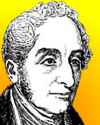 (source)
(source)
|
Henry Fourdrinier
(11 Feb 1766 - 3 Sep 1854)
English inventor of paper-making machinery known by his name, which is still at the core of modern continuous production equipment.
|
Henry Fourdrinier - Patent 3068

14 August 1807
Henry Fourdrinier, Sealy Fourdrinier and John Gamble
“Making paper by means of machinery.” This invention consists “in the using of a revolving web of”wire, or other similar material or thing applicable in like manner as such web, the same being made endless by joining its ends together, similar to a round towel, or by having it wove endless, and applying such web to the making or manufacturing of paper according to the arrangement and application of the revolving or endless web before mentioned in connection with other mechanical apparatus.The paper pulp in the vat, which is kept agitated, being brought by admixture of water to the required consistency, is suffered to run through certain appertures in the side or front of the vat, the flow being regulated by a slide valve, and conducted from thence by an inclined plane in an uniform stream upon the surface of the revolving web [called the under web], which is so placed that its surface shall be as nearly level as possible, and have its revolving motion in the direction in which the stream of pulp runs from the vat.
The endless web is caused to revolve round two extreme rollers, and several small rollers are placed under the upper part, upon which the paper is formed, to support the travelling bed with its weight of paper. The width of the sheet of paper is determined by two pieces of wood placed on the travelling bed, and pressing on two endless belts of leather, which travel with the endless web, one on each side; corresponding pieces of wood and travelling straps being also applied under the travelling bed. These together are called “dickles.”A flap of oiled silk is placed where the pulp falls on to the web of wire, one edge of which rests on the surface of the web, and extends from dickle to dickle, for the purpose of preventing the pulp from flowing backwards.
As the web progresses forward with the coating of paper upon it, it is caused to pass between two rollers covered with felts or flannel, called “the wet press rollers;” and in order to protect the pulp from injury by friction of the upper one of these rollers, and the shorter endless web (called the upper web), which may be made of felt, is caused to travel with and above it, so as to be constantly inter-posed between the pulp and the upper wet press roller. The paper after having been thus passed between the wet press rollers is conducted on to another endless web, called the felting, by means of the roller called the “couching roller,” and is carried forward and caused to pass between two “dry press” rollers made of brass, and turned perfectly true, to which considerable pressure may be given. The paper is then sufficiently dry to be wound on reels.
To the roller nearest the vat, round which the “under web” revolves, a quick shaking motion may be given, by means of a crank which is communicated to the web. The endless webs are provided with suitable means for adjusting their tension, and with guides for conducting them in a proper direction, and correct speeds of all the parts is secured by means of adjustable or expanding riggers or hand wheels, as described and shown in the drawing. The water which falls from the web, which contains “paper stuff, blue, size, &c.,” may be returned to the vat by means of pumps or elevating scoops.
The paper, when manufactured, is drawn off the reel, and placed on a table to be cut into sheets. This operation may be effected by placing one or more pairs of steel plates across and level with the surface of the table, the upper edges of which should be parallel with and about one-twentieth of an inch from each other, and causing a corresponding number of small wheels, fitted in a frame with an edge sharpened by being basilled away on both sides, similar to the edge of a hard or cold chisel, to roll across from one side of the table to the other, the edges of these wheels being applied between the opposed edges of the plates. These plates are placed angularly towards each other, and in section are like the strokes of the letter A; the outer edge of each being basilled off by grinding.
- 11 Feb - short biography, births, deaths and events on date of Fourdrinier's birth.
- The Fourdrinier Paper-Making Machine - from Paper Manufacturing in the United States (1916).
- The Fourdrinier Paper-Making Machine - from Paper & Paper Making Ancient and Modern (1863).
- Fourdrinier Patent 2950 (1806) - A machine for cutting paper on a different principle from any hitherto used.
- Fourdrinier Patent 2951 (1806) - Method of making a machine for manufacturing paper of an indefinite length, laid and wove, with separated moulds.
- Henry Fourdrinier Biography - from Dictionary of National Biography (1889).
- Henry Fourdrinier Obituary from Gentleman's Magazine (1855).
- 24 Jul - events for date of patent on Paper-Making Machine.




